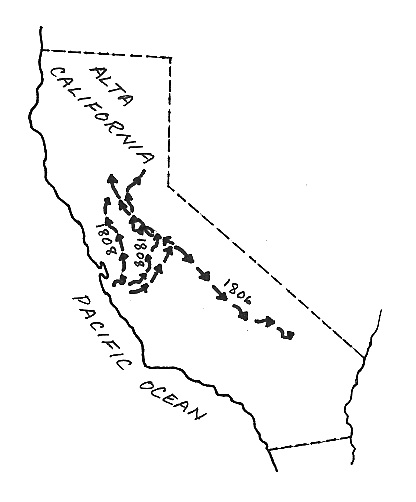| ||||
|
| ||||
|
GABRIEL
MORAGA
 Lived:
1765-1823
Lived:
1765-1823
Explored California in: 1805-1817
Exploring for: Spain
Explored: by land in the Central Valley
Even after
EARLY HISTORY
Gabriel Moraga was born in
Gabriel grew up in the frontier
settlement that became San Francisco. He was a soldier like his father. Gabriel
was assigned to the pueblo (town) of San Jose but was transferred in
1797 to the pueblo of Branciforte, near Monterey. This was a difficult post,
for Branciforte was settled mainly by people who had been accused of crimes
in
BACKGROUND
California has two mountain ranges running north-south through much of the state. On the eastern edge is the Sierra Nevada, a barrier to anyone further east who thought of exploring California. On the west is the Coast Range, another barrier. Between these lies the great Central Valley, called Valle Grande by the Spanish. It is about 450 miles long and an average of 50 miles wide. This area was unknown wilderness to the early Spaniards.
The first recorded notice of the Central Valley was in 1772 when Lt. Pedro Fages led a group from Monterey to explore the east side of San Francisco Bay. Unable to cross the delta of the Sacramento River, the group turned east into what is now Contra Costa County. From a hill, they looked down into the Central Valley to the east.
The Central Valley was home to many villages of Miwok, Yokuts, and other Indians who made use of the abundant natural resources of the valley.
Early excursions into the valley by Spanish soldiers were made in search of Indians who had left one of the missions. As a military officer, Gabriel Moraga commanded a number of these expeditions. It is recorded that he took part in at least 46 campaigns against Indian groups.
There was also some interest
on the part of the Spanish government in establishing more missions in the
inland areas. From time to time in the early 1800s they sent small groups
out to look for possible mission sites. However, Spanish support of the California
settlements was weakening. After 1810 the supply ships from
MORAGA’S JOURNEYS
Between 1805 and 1817, Gabriel Moraga led many expeditions into the Central Valley. By 1807 he had explored most of central California as far east as the foothills of the Sierra Nevada.
His first journey into the San Joaquin Valley took place in June 1805. He was sent by the Spanish officials to look for a site for a new mission. He crossed into the valley on June 21 through what is now known as Pacheco Pass, south of San Francisco Bay. The route that Moraga opened later became a stagecoach road and then a freeway, one of the main routes between the coast and the Central Valley. A California State Historical Landmark plaque (#829) marks Moraga’s trail.
On this trip, Moraga explored the area that is now Kings County. He named the river there El Rio de los Santos Reyes, the River of the Holy Kings, because he first saw it on January 6, the feast day of the Three Kings. The name was later shortened to Kings for the river, the county, and the canyon.
In 1806 Moraga and a group of 26 men explored the area of the Stanislaus River, which was later named for Estanislao, the Indian leader. They passed a slough where butterflies were swarming, and Moraga named it Las Mariposas (Spanish for “butterflies”). He also named El Rio de Nuestra Señora de la Merced, or the River of Our Lady of Mercy, from which Merced County is named.
On an expedition in 1808 Moraga named the Sacramento River and the Calaveras River, where he saw skulls (calaveras in Spanish). He is also credited with naming the San Joaquin River. He explored most of the rivers flowing out of the Sierra Nevada, and gave names to many places.
Though Moraga was the first European to travel through the area where gold was later discovered, he did not report on any signs of minerals.
WHAT HE ACCOMPLISHED
Gabriel Moraga is called the greatest pathfinder of his day. He is credited with opening the inland areas to settlement from the coast. Many of the names he gave to places in the Central Valley are still in use today. Sadly, he is also known as the greatest Indian fighter of his day. He was responsible for the deaths of many Indians.
LATER YEARS
Gabriel Moraga was given the rank of lieutenant in 1811, but this advancement was for the attacks he organized against the Indians. Later he made several trips to Fort Ross, on the coast to the north. He was sent to investigate what the Russians were doing there. He found that they were having a hard time getting enough food, and he gave them cattle and wheat in trade for furs.
Gabriel’s son, Joaquin, owned a rancho in what is now Contra Costa County. His adobe house, built in 1841 on a hill overlooking the Moraga Valley, is a California Historical Landmark. The town of Moraga is named for Joaquin Moraga.